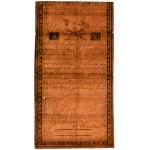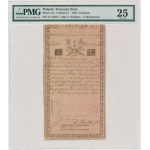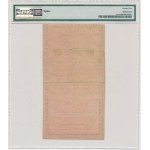An extraordinary rarity, the appearance of which will surprise many experienced collectors of the Kościuszko period. Kościuszko banknote printed on paper with filigree from the extremely rare company Jan Kool & C.
The Jan Kool & C. filigree is the only one written in italics, all other filigrees are written in capital letters.
Quoting from Czesław Miłczak, "Banknotes of the Kościuszko Insurrection with watermarks (filigrees) of Dutch companies: Jan Kool & C. and ADSCHUT & C. are extremely rare - they are usually 5-zloty banknotes. Reading these marks (inscriptions) is difficult because "they are often on the verge of cutting the banknotes."
It is no different in the offered case, where fragments of the filigree inscription are visible on the edge of the banknote field. The offered item has a denomination of 5 zloty and, according to our observations, it is only on this denomination that the Jan Kool & C watermark can be found.
Graded PMG 25.
Dry stamps are legible. The banknote shows no traces of washing and pressing.
The offered banknote is the first known piece with the Jan Kool & C filigree. According to our information, this is the last of the discovered filigrees appearing on Kościuszko's banknotes, which is considered the rarest of all. The community of collectors of Polish paper money has been aware of rare filigrees for several years, but we have not yet seen their quotations. Based on conversations with advanced collectors of Kościuszko banknotes there is no more than one other banknote known in private collections, so in total, together with the offered piece, there are only two pieces known with this unique, italicized filigree.
A truly unique banknote, an absolute rarity, that is a living example that there is still much to discover in terms of filigree on Kościuszko banknotes.
In Poland, the introduction of paper money into circulation was related to expenses related to the outbreak of the Kościuszko Uprising. Its issuer was the Directorate of Treasury Tickets appointed by the Supreme National Council. In terms of value, treasury tickets were equal to a coin. Liabilities to the State Treasury could be repaid in a maximum of 50% in paper money and the remaining part in coins. This condition resulted in his negative perception by society. In the future, the purchase of treasury tickets was to be financed from national assets. The penalty for counterfeiting paper money was death and confiscation of all the perpetrator's property. On September 29, 1794, in order to strengthen confidence in treasury tickets, the Supreme National Council allowed the entire amount to be paid in paper groszes and zlotys. Due to the failure of the uprising, public trust in paper money decreased. The population preferred to accept metallic money in settlements. The scope of the issue of the first Polish paper money was small - they were introduced on a large scale only in Warsaw. After the capital was captured on November 6, 1794, the people were left with tickets of all denominations for a total amount of PLN 7.8 million.
On June 8, 1794, the Supreme National Council resolved to establish an issuing institution - the Directorate of Treasury Tickets - and to introduce treasury tickets in denominations of 5, 10, 25, 50, 100, 500 and 1,000 Polish zlotys. Treasury notes with an issue date of June 8, 1794 are very similar to each other. These are single-sided prints in the form of a standing rectangle, differing only in colors and details in the frame. Each denomination was hand-numbered and signed by two or three representatives of the Treasury Tickets Directorate. Additionally, each ticket has a dry stamp of the Treasury Tickets Directorate.
After printing, paper money of the same denomination was stapled together in the form of a cloth-bound "book". When they were put into circulation, they were hand-cut, which is why tickets of one denomination differ in dimensions and the shape of the upper edge. The part remaining in the "book" and the currency released into circulation have the same number.












